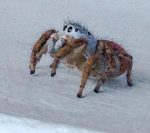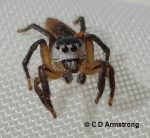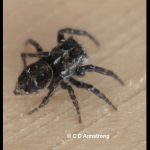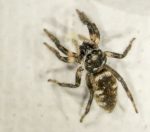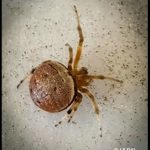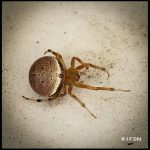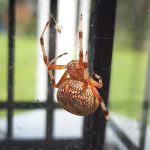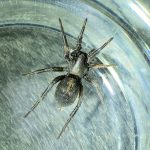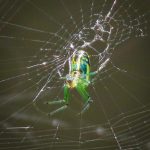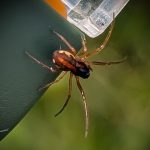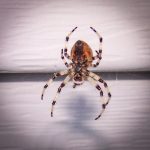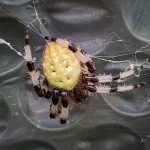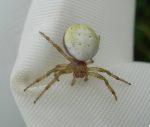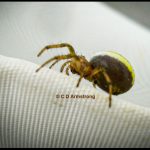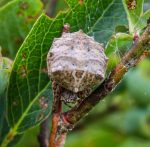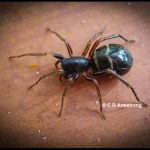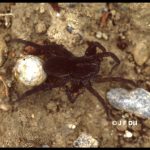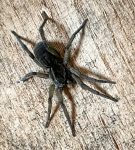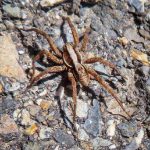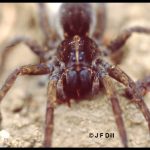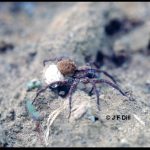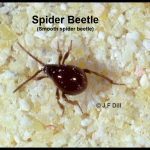Spiders
Do you have a spider that you would like to have identified? Try out our new Photo Submission Form (it’s free)!
Spiders have been the subject of negative publicity for years. Their secretive nature, way of moving, and predatory nature make them common villains in folklore and popular media. Fear of a few highly venomous spiders, such as black widow and brown recluse spiders, has expanded to include all spiders. Fortunately, black widows (specifically the “Southern Black Widow”) and brown recluse spiders are not native to Maine. In fact, there are no ‘Maine-native’ spiders whatsoever that are considered particularly “dangerous” to humans.
Spiders can be considered to be beneficial when they feed on household and garden insect pests. It is unfortunate that many incidents of unknown skin irritation are attributed to spider bites. People do sometimes get bitten, however, and the sensitivity to a spider bite varies from person to person. In rare cases, some individuals with highly sensitive or weakened immune systems may have a significant or even severe reaction to a bite from an otherwise harmless spider, and there are many spiders that people mistakenly suspect to be the Brown Recluse. Misdiagnoses are thus very common. See also: University of California Riverside’s Causes of Necrotic Wounds other than Brown Recluse Spider Bites
Additional Information:
- Spiders (UMaine Extension)
- Spiders (Penn State Extension)
- Spiders (Joint publication between Minnesota, Wisconsin and Iowa)
- Maine’s largest spiders: Fishing Spiders
- Information about Spider Bites from the Mayo Clinic
Photos of Many Different Kinds of Spiders Found in Maine:
- American Nursery Web Spider (Pisaurina mira) (Wiscasset, ME; 6/5/2024) (Photo courtesy of K. Draper)
- American Nursery Web Spider (Pisaurina mira)
- American Nursery Web Spider (Pisaurina mira) (a less common form) (Woolwich, ME; 8/1/2025) (Photo courtesy of Phil Baton)
- Arrowshaped Micrathena / Arrow-shaped Orbweaver (Micrathena sagittata) (Jefferson, ME; 8/6/2024) (Photo courtesy of Kyrill Schabert)
- Arrowshaped Micrathena / Arrow-shaped Orbweaver (Micrathena sagittata) (near Lower Kimball Pond in Fryeburg, ME; 9/4/2023) (Photo courtesy of Ryan Day)
- Banded Argiope / Banded Garden Spider (dorsal view) (Dennysville, ME; 9/17/2010)
- Banded Argiope / Banded Garden Spider (ventral view) (Dennysville, ME; 9/17/2010)
- Black and Yellow Garden Spider with her egg sac
- Garden Spider (Black and Yellow Garden Spider / Golden Garden Spider / Writing Spider / Corn Spider) (in a cranberry patch; 8/31/2011)
- Barn Funnel Weaver (Tegenaria domestica) (was found indoors; Passadumkeag, ME; 8/11/2023)
- Barn Funnel Weaver (a closer view of the adjacent specimen)
- Boreal Combfoot (Steatoda borealis) (female) (Members of the Steatoda genus are called “False Widow” spiders)
- Boreal Combfoot (Steatoda borealis) (female) (Found inside a house; Etna, ME; 4/23/2021)
- Broad-faced Sac Spider (Trachelas tranquillus) (Portland, ME; 9/8/2025) (they often wander indoors by accident, especially in the fall) (Photo courtesy of Christie Constantine)
- Cellar Spider (female with egg sac)
- Cellar Spider (Old Town, ME: 7/23/2022)
- Cellar Spider
- Crab Spider (Family: Thomisdae)
- Crab Spider
- Goldenrod Crab Spider (Misumena vatia) (feasting on a fly while perched on the inflorescence of a Queen Anne’s Lace plant)
- Goldenrod Crab Spider (Misumena vatia) on a red clover flower
- Multicolored Bark Crab Spider (Bassaniana versicolor) (Jefferson, ME; 6/23/2025) (Photo courtesy of Kyrill Schabert)
- Running Crab Spider (Philodromus genus) (Jefferson, ME; 6/19/2025) (Photo courtesy of Kyrill Schabert)
- White-striped Running Crab Spider (Philodromus rufus) (Alfred, ME; 6/27/2025) (Photo courtesy of Judee Meyer)
- Cross Orbweaver spiderlings (newly hatched) (Sedgwick, Maine; 6/2/2021) (Photo courtesy of David J. Snyder)
- Cross Orbweaver spiderlings (newly hatched) (Sedgwick, Maine; 6/2/2021) (Photo courtesy of David J. Snyder)
- Cross Orbweaver (Glenburn, ME; 8/5/2020) (photo courtesy of Samantha K.)
- Cross Orbweaver (Araneus diadematus) (St. George, ME; 8/31/2024) (Photo courtesy of B. Mroz)
- Banded Fishing Spider (Dolomedes vittatus) (Etna, ME; 3/21/2019)
- Sixspotted Fishing Spider (Dolomedes triton) (perched on a car visor; 5/9/2024; Sangerville, ME) (Photo courtesy of Kelsey Shannon)
- Striped Fishing Spider (Dolomedes scriptus) (Photo courtesy of H. Leighton)
- Another species/example of a Fishing Spider (either Dolomedes scriptus or Dolomedes tenebrosus)
- Eastern Parson Spider
- Eastern Parson Spider (photo courtesy of Jon McCann)
- Fierce Orbweaver (Araneus saevus) (Holden, ME; 10/4/2025) (Photo courtesy of Deb Schmidt)
- Fierce Orbweaver (Araneus saevus) (Orono, ME; 10/8/2025) (Photo courtesy of Meg Schierer)
- Filmy Dome Spider (Neriene radiata) (Etna, ME; 8/2/2009)
- Funnel Weaver perched near the entrance to its webbed funnel
- Funnel Weaver (possibly in the genus Agelenopsis — Grass Spiders) (August 28th, 2017; Etna, Maine); Similar specimen on BugGuide.net
- Funnel Weaver (Family Agelenidae)
- Funnel Weaver (Family Agelenidae)
- Furrow Orbweaver (Larinioides cornutus) (Livermore, ME; 9/18/2025) (Photo courtesy of Morgan McDonald)
- Garden Ghost Spider (Hibana gracilis) (Lewiston, ME; 11/17/2024) (Photo courtesy of Nicole Pollock)
- Giant Lichen Orbweaver (Araneus bicentenarius) (Stetson, ME; 6/7/2023)
- Giant Lichen Orbweaver (Araneus bicentenarius) (Stetson, ME; 7/8/2009; resting on the frame of a screen door)
- Gray Cross [Orbweaver] Spider / Bridge Spider (male) (Larinioides sclopetarius) (Orono, ME; 7/4/2024) (Photo courtesy of Drew Parent)
- A species of Jumping Spider (Habronattus decorus) (Warren, ME; 7/21/2020) (size: roughly 8-10 mm)
- A species of Jumping Spider (Habronattus decorus) (Troy, ME; 6/18/2008) (size: roughly 8-10 mm)
- Jumping Spider
- Bronze Jumper (Eris militaris) (jumping spider) (10/10/2010; Etna, ME)
- Bronze Jumper (Eris militaris) (jumping spider) (10/10/2010; Etna, ME)
- Zebra Jumper (Salticus scenicus) (Etna, ME; 7/20/2023)
- Lattice Orbweaver (Araneus thaddeus) (Old Town, ME; 9/26/2025)
- Lattice Orbweaver (Araneus thaddeus) (Old Town, ME; 9/26/2025)
- Marbled Orbweaver (Araneus marmoreus) (Hermon, ME; 8/28/2024) (Photo courtesy of Eric H)
- Moss Ground Hunter (Gnaphosa muscorum) (Rockland, ME; 8/31/2024) (Photo courtesy of Jay Witham)
- Moss Ground Hunter (Rockland, ME; 8/31/2024) (Photo courtesy of Jay Witham)
- Orchard Orbweaver (Leucauge venusta) (North Anson, ME; 6/27/2024) (Photo courtesy of Carol Lehto)
- Pachygnatha autumnalis (a species of Long-jawed orbweaver; Family Tetragnathidae) (Owls Head, ME; 9/28/2024) (Photo courtesy of Steven Kozidis)
- Shamrock Orbweaver (Araneus trifolium) (Lamoine, ME; 9/4/2025) (Photo courtesy of Kath)
- Shamrock Orbweaver (Araneus trifolium) (Portland, ME; 8/21/2024) (the color varies greatly amongst females of this species) (Photo Courtesy of Tricia Carbonneau)
- Sixspotted Orbweaver (female) (Araniella displicata) (Troy, ME; 7/2/2009)
- Sixspotted Orbweaver (female) (Araniella displicata) (Troy, ME; 7/2/2009) (lateral view of the adjacent specimen)
- Starbellied Orbweaver (Acanthepeira stellata) (Howland, ME; 6/29/2023) (Photo courtesy of Paula S.)
- Twobanded Antmimic (female) (Castianeira cingulata) (Stetson, ME; 6/1/2012)
- Tiger Wolf Spider female (with egg sac) (Tigrosa aspersa)
- Tiger Wolf Spider (female) (Tigrosa aspersa) on the side of a horse barn (Buxton, ME; 10/24/2023) (Photo courtesy of Kelly Weymouth)
- Tiger Wolf Spider (female) (Tigrosa aspersa) (closer view of adjacent specimen) (Buxton, ME; 10/24/2023) (Photo courtesy of Kelly Weymouth)
- Wolf Spider (Hogna frondicola) (Old Town, ME; 4/24/2022) (Photo credit: courtesy of Edward S. Grew)
- Wolf Spider
- Wolf Spider (with egg sac)
- Example of a Spider Beetle (Spider Beetles are small beetles that superficially resemble spiders but are harmless)
One can find additional spider images at BugGuide.net.
Additional Information Regarding Specific Spiders:
- American Nursery Web Spider (Pisaurina mira) (BugGuide.net)
- Arrowshaped Micrathena (Micrathena sagittata) (BugGuide.net)
- Banded Argiope (Argiope trifasciata) (BugGuide.net) | Banded Garden Spider (Penn State)
- Barn Funnel Weaver (Tegenaria domestica) (Penn State) | Barn Funnel Weaver (BugGuide.net)
- Barn Spider (Araneus cavaticus) (BugGuide.net) (The character of “Charlotte” from E. B. White’s Charlotte’s Web was modeled on this species)
- Black and Yellow Garden Spider (Argiope aurantia) (Penn State) | Black and Yellow Argiope (BugGuide.net)
- Boreal Combfoot (Steatoda borealis) (BugGuide.net) (spiders in this genus are known as “False Widows“) See also: False Black Widow Spider (Penn State) | Closely related species: Triangulate Combfoot (BugGuide.net)
- Bridge Spider / Gray Cross Spider (BugGuide.net)
- Broad-faced Sac Spider (BugGuide.net)
- Bronze Jumper (BugGuide.net)
- Cellar Spiders / Longbodied Cellar Spiders
- Crab Spiders (Family: Thomisdae)
- Goldenrod Crab Spider (BugGuide.net)
- Multicolored Bark Crab Spider (BugGuide.net)
- Running Crab Spiders (Family: Philodromidae) — Their 2nd pair of legs are longer than their first pair of legs.
- Red and Yellow Running Crab Spider (Philodromus exilis) (BugGuide.net)
- White-striped Running Crab Spider (Philodromus rufus) (BugGuide.net)
- Cross Orbweaver / Cross Spider (Araneus diadematus) (BugGuide.net)
- Eastern Parson Spider (Penn State)
- False Black Widow Spider (Penn State)
- Fierce Orbweaver (BugGuide.net)
- Filmy Dome Spider (a type of sheetweb spider) (BugGuide.net)
- Fishing Spiders (Maine’s largest spider)
- Dark Fishing Spider (BugGuide.net)
- Sixspotted Fishing Spider (BugGuide.net)
- Striped Fishing Spider (BugGuide.net)
- Funnel Weavers (Family: Agelenidae) (BugGuide.net)
- Barn Funnel Weaver (Tegenaria domestica) (Penn State)
- Grass Spiders (genus Agelenopsis) (Penn State)
- Furrow Orbweaver (BugGuide.net)
- Garden Spider (Argiope aurantia) (Penn State)
- Garden Ghost Spider (Hibana gracilis) (BugGuide.net)
- Giant Lichen Orbweaver (BugGuide.net)
- Grass Spiders (genus Agelenopsis) (Penn State)
- Gray Cross [Orbweaver] Spider / Bridge Spider (BugGuide.net)
- Ground Spiders (Family Gnaphosidae)
- Eastern Parson Spider (Penn State)
- Moss Ground Hunter (BugGuide.net)
- Hacklemesh Weaver Spiders (Penn State)
- Jumping Spiders (University of Arizona)
- Bronze Jumper (BugGuide.net)
- Habronattus decorus (BugGuide.net)
- Zebra Jumper (Salticus scenicus) (BugGuide.net)
- Lattice Orbweaver (Araneus thaddeus) (BugGuide.net)
- Marbled Orbweaver (Penn State)
- Nursery-Web & Fishing Spiders (Family: Pisauridae) (University of Kentucky)
- American Nursery Web Spider (Pisaurina mira) (BugGuide.net)
- Dark Fishing Spider (BugGuide.net)
- Sixspotted Fishing Spider (BugGuide.net)
- Orbweavers (Family Araneidae)
- Arrowshaped Micrathena (Micrathena sagittata) (BugGuide.net)
- Banded Argiope (BugGuide.net) | Banded Garden Spider (Penn State)
- Barn Spider (Araneus cavaticus) (BugGuide.net) (The character of “Charlotte” from E. B. White’s Charlotte’s Web was modeled on this species)
- Bridge Spider / Gray Cross Spider (BugGuide.net)
- Cross Orbweaver / Cross Spider (BugGuide.net)
- Fierce Orbweaver (BugGuide.net)
- Furrow Orbweaver (BugGuide.net)
- Garden Spider (Penn State)
- Giant Lichen Orbweaver (BugGuide.net)
- Gray Cross [Orbweaver] Spider / Bridge Spider (BugGuide.net)
- Lattice Orbweaver (Araneus thaddeus) (BugGuide.net)
- Marbled Orbweaver (Penn State)
- Orchard Orbweaver (BugGuide.net)
- Shamrock Orbweaver (BugGuide.net)
- Sixspotted Orbweaver (BugGuide.net)
- Starbellied Orbweaver (BugGuide.net)
- Orchard Orbweaver (BugGuide.net)
- Pachygnatha autumnalis (BugGuide.net)
- Shamrock Orbweaver (BugGuide.net)
- Sixspotted Orbweaver (BugGuide.net)
- Starbellied Orbweaver (BugGuide.net)
- Triangulate Combfoot (BugGuide.net)
- Twobanded Antmimic (BugGuide.net)
- Wolf Spiders (Penn State)
- Hogna frondicola (BugGuide.net)
- Tiger Wolf Spider (Tigrosa aspersa) (BugGuide.net)
- Tigrosa helluo (BugGuide.net)
- Zebra Jumper (Salticus scenicus) (BugGuide.net)
Not Native To Maine or Rarely Found In Maine:
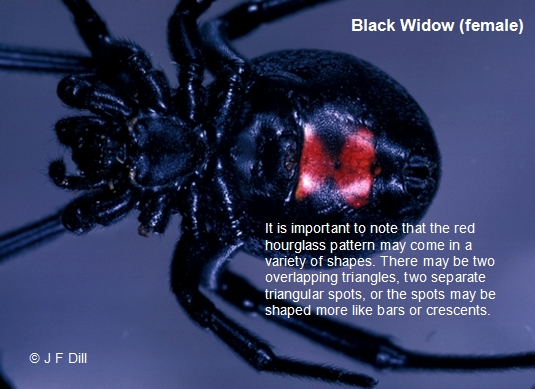 Black Widow / Southern Black Widow (Latrodectus mactans) (Cornell) — Non-native, but sometimes hitches a ride into Maine via packages, cargo, etc.–most often via shipments of produce from out-of-state; See also: False Black Widow Spider — a genus of spiders that we do have in Maine! (Penn State)
Black Widow / Southern Black Widow (Latrodectus mactans) (Cornell) — Non-native, but sometimes hitches a ride into Maine via packages, cargo, etc.–most often via shipments of produce from out-of-state; See also: False Black Widow Spider — a genus of spiders that we do have in Maine! (Penn State)- Northern Black Widow (Latrodectus variolus) — This spider may be an infrequent inhabitant as far north as central Maine and southern portions of Canada. The red hourglass pattern on the Northern Black Widow has a gap between the top and bottom halves of the hourglass.
- Northern Black Widow (Michigan State University)
- Northern Black Widow (BugGuide.net)
- Photo of a Female (ventral view): Northern Black Widow (Smithsonian)
- Photo example from Canton, Massachusetts of the dorsal pattern: Northern Black Widow (BugGuide.net)
- Brown Recluse (Penn State) (Non-native, and thus extremely rare in Maine–an encounter is only possible if a specimen is brought in from out-of-state) (US Distribution Map for Brown Recluse)
- Hobo Spider (also known as the Aggressive House Spider) (UC-Davis)

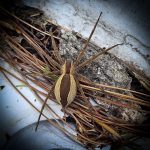
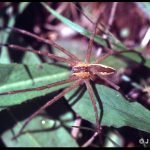
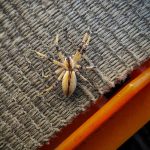
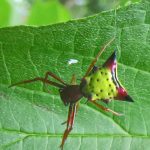
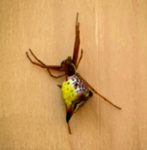
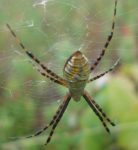
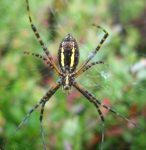
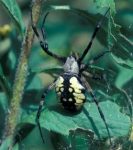
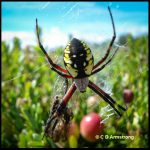
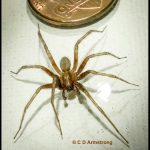
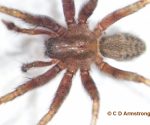
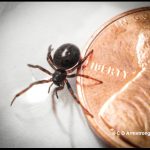
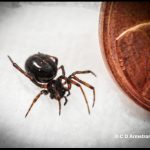


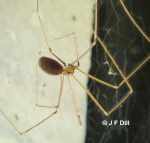
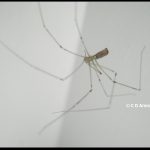

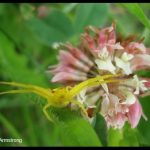
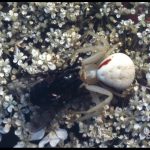
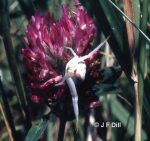
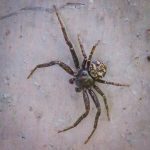
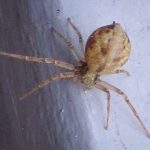

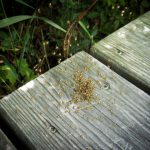
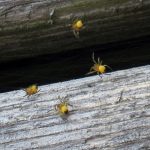
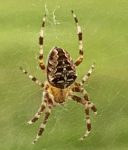
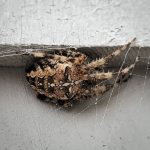

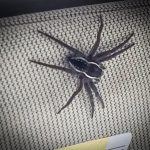
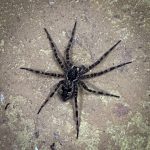
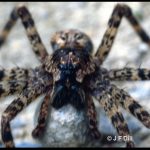
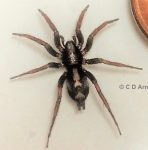
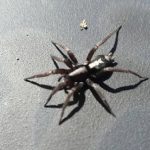


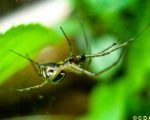
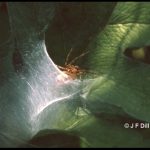


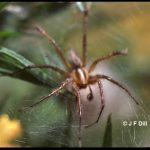
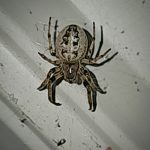
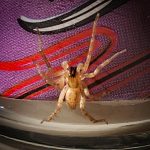
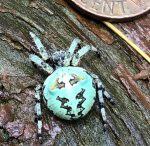
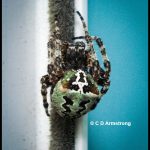
![a male Gray Cross [Orbweaver] Spider (also called a Bridge Spider) (Larinioides sclopetarius) (Orono, ME; 7/4/2024) (Photo courtesy of Drew Parent)](https://extension.umaine.edu/home-and-garden-ipm/wp-content/uploads/sites/43/2024/07/Gray-Cross-Orbweaver-Larinioides-sclopetarius-DParent-150x150.jpg)
